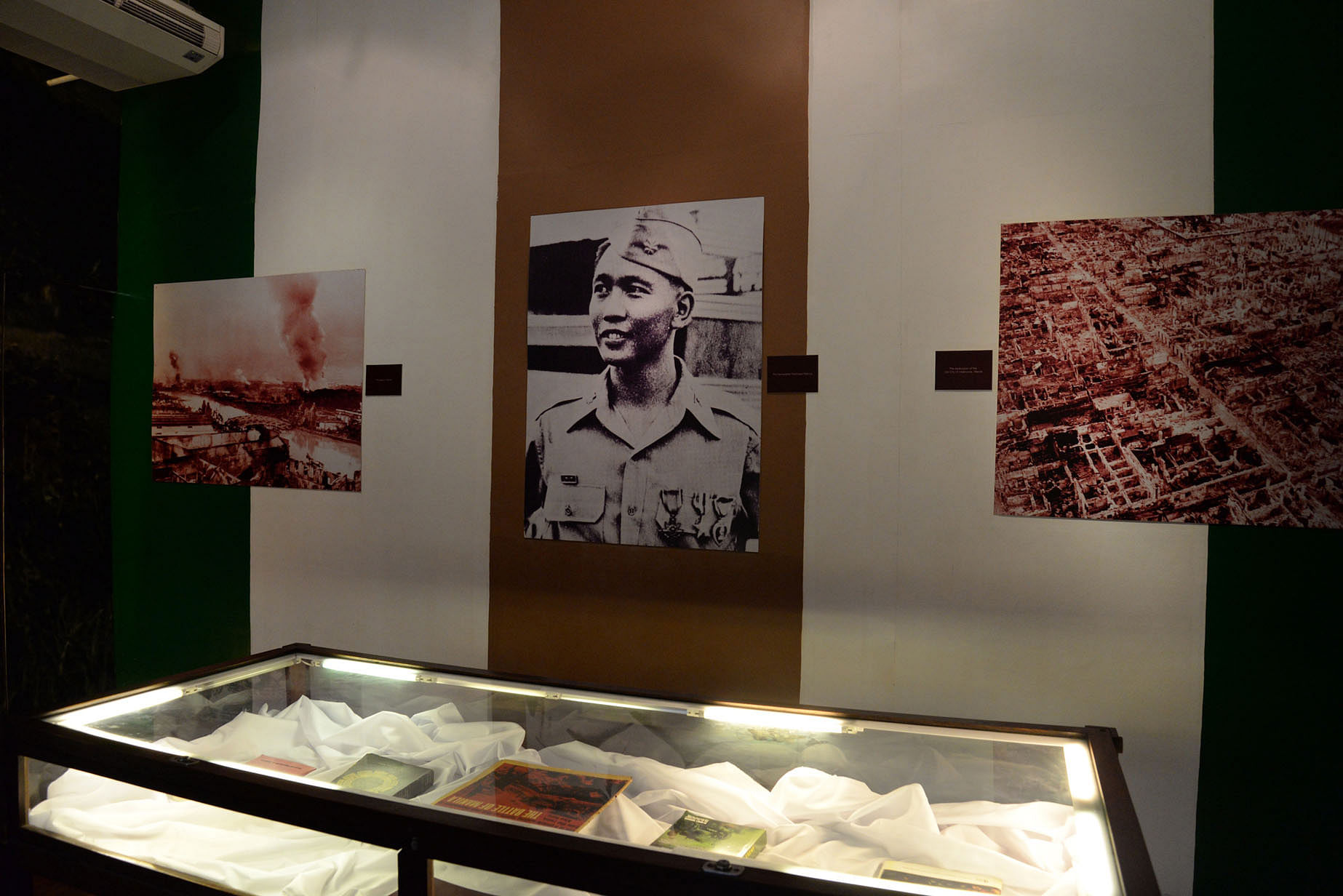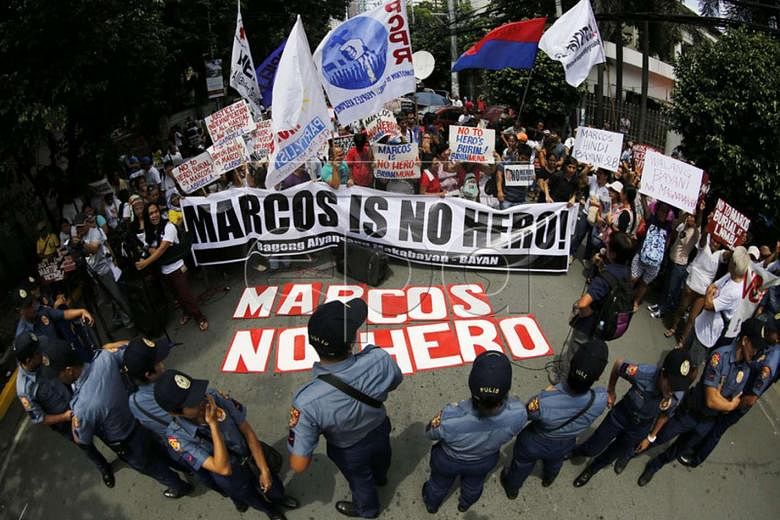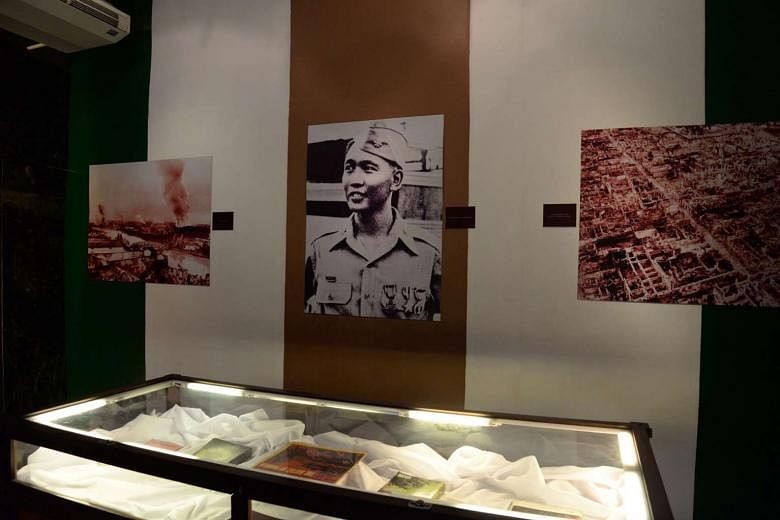BATAC (Ilocos Norte) • Former Philippine president Ferdinand Marcos died 27 years ago. Yet, the dictator who ruled for more than 20 years and amassed an estimated US$10 billion (S$13.5 billion) in plundered wealth has been as divisive in death as he was when he was alive.
He died in exile on Sept 28, 1989, four years after a popular, military-backed revolt forced him and his family to flee to Hawaii.
In 1993, his corpse was flown back to the Philippines. He was to be buried in Batac, his hometown in Ilocos Norte province, 470km north of the capital Manila, under a deal the Marcos family struck with then President Fidel Ramos.
But the family reneged on that agreement. Instead, they installed the corpse inside a glass box at a mausoleum in Batac, where it remains. The Marcoses want to bury their patriarch at the Libingan ng mga Bayani (Heroes' Cemetery), a 142ha cemetery in Manila where some of the nation's leaders and war heroes are buried.
He was a hero, not a disgraced despot, they insist.
OPEN WOUNDS
But for those who fought the Marcos regime, a burial at the Heroes' Cemetery for the dictator would rewrite history.
More than 90,000 were jailed, and nearly 6,000 tortured during martial law from 1972 to 1983. At least 2,500 were summarily executed. The victims and their relatives say laying Marcos to rest in the same cemetery as those who suffered under his rule would be an insult. "The Libingan ng mga Bayani is the hallowed graveyard for heroes and patriots, not of despots and plunderers," Representative Edcel Lagman, 74, a human rights lawyer during the Marcos years, said in a privilege speech in Congress last month.

They say it could also obfuscate the brutality of martial law and even put strongman rule in a positive light.
For Mr Bonifacio Ilagan, a poet who was among those jailed during the martial law years and whose sister was raped and executed by security forces serving Marcos, the burial "is a question of justice, and justice has not been rendered to the victims of martial law".
He was arrested in 1974, taken to a cell and tortured for months. "It went on for days and weeks and months. The punches, the kicks. There was a point when they'd beat me up just because they wanted to," he said. Soldiers took turns to beat his legs with an empty soda bottle.
"I thought, ' This is nothing.' But then, they wouldn't stop for an hour. My legs got so sore, so swollen that I'd sob when I tried to move them," he said.

Reliving her ordeal this month at a Supreme Court hearing on the Marcos burial issue, Ms Trinidad Herrera-Repuno, an organiser of poor communities, recalled a telephone that was connected to an electrical outlet. "They forced me to take off my blouse and then put the wire to my breast, allowing the current to run through my whole body," she told the court.
Mrs Priscilia Mijares, wife of a journalist who criticised Marcos, remembered seeing her 16-year-old son, Boyet, leave home one day in 1977. The next time she saw him, days later, was at a morgue. She was told the boy was thrown out of an army helicopter.
Past governments had refused to give in to the Marcoses. Not even former president Joseph Estrada, 79, an actor who owed his political career to Marcos, was swayed.
A MORE FORGIVING GENERATION
But 30 years have passed since the 1986 "People Power" revolt that unseated Marcos. An entire generation of Filipinos has since emerged. They now make up a third of today's registered voters.
Born after 1986, most of them know Marcos only from grainy, black-and-white clips on YouTube and from what they have been told in school. They also feel that the 1986 uprising did not live up to its promises, and they are the ones suffering for it. That disconnect has made them more forgiving.
Marcos was bad, they believe, but with life having improved little since 1986, he may not be worse than any of the five presidents that followed him.
Not a few believe that the Marcos years, in fact, marked a "golden age" for the Philippines, and that "People Power" messed it all up.
"The millennials don't have a memory of martial law. The administrations that came after Marcos did not systematically ingrain in the minds of Filipinos what happened during martial law. It's too late to do that now," said Dr J. Prospero de Vera, professor of public administration at the University of the Philippines.
ALONG COMES DUTERTE
Then, there is the new president, Mr Rodrigo Duterte. The 71-year-old former mayor has signed off on a hero's burial, including military honours, for Marcos. Mr Duterte, whose late father served Marcos as a Cabinet minister, won in the province of Ilocos Norte, the Marcoses' stronghold, in the national elections. He believes that the May election was a referendum on the Marcos burial.
Marcos' son and namesake received over 14.1 million votes when he ran for vice-president. He lost to Mrs Leni Robredo, an ally of Mr Duterte's predecessor, Mr Benigno Aquino, but by just 263,000 votes.
"Almost half of the country says he was a good president," said Mr Duterte of Marcos. He may have a point. A recent poll shows three in five Filipinos believe Marcos "deserved to be buried with official honours". That sentiment runs deepest among Ilocanos.
THE 'SOLID NORTH'
Ilocanos form a solid voting bloc of more than five million known as the "Solid North". It covers three regions in the northern part of the main island of Luzon, where a majority of the population share the same dialect: Ilocano.
This bloc has been "Marcos country" for decades, and it will likely remain so for years to come. It forms the foundation for the stunning return of the Marcoses to political prominence.
My father is an Ilocano. He was born in Cabulalaan, a district in Sinait, a town of 25,000 in Ilocos Sur known for two things: garlic and a centuries-old image of the Black Christ. When I was a boy, my father would take me with him to Sinait for the summer breaks. This was in the 1970s, when the Philippines was under martial rule.
What I remember most was how difficult it was to get to my grandmother's hut.Cabulalaan was nothing more than a smattering of huts, clay furnaces for drying tobacco, vegetable farms, chicken coops and rivers. There was no electricity or running water, just candles and deep wells.
I remember wanting to sleep in a hammock tied to a tree at night, but my grandmother said I couldn't because there were "bad men" - communist partisans - who regarded Cabulalaan as theirs.
THE MARCOS NAME
Fast-forward 30 years and a paved road, lit by lamp posts, now leads to Cabulalaan. There are more houses, made of concrete, iron and steel. It is lit up at night, and homes now have taps and toilets.The communists are still around, but they have moved farther into the mountain.
Talk to anyone there, and they will say they owe this much progress to the Marcoses.
Three generations of Marcoses are now holding sway over politics in Ilocos Norte. Mrs Imelda Marcos, 86, is on her third term as congressman. Her eldest daughter, Imee, 60, has been re-elected governor, while a grandson, Matthew, just 26, sits as a member of the provincial board.
It's not just the name that has kept the family in charge. Under their watch and despite often testy relations with the central government, Ilocos Norte has grown to be a bustling gateway in northern Philippines.
Shopping malls and call centres are rising in the provincial capital Laoag, and the Philippines' largest "wind farm" sits in the northern town of Burgos.
Ilocanos believe that prosperity began with Marcos. For Mr Richard Piano, 42, who makes a living driving a horse-drawn carriage in Vigan city, in Ilocos Sur, Marcos, at his peak, was always the smartest man in the room, and that alone justifies a hero's burial.
HIGH COURT TO DECIDE
That question, though, is now up to the Supreme Court to decide. Oral arguments are being heard on six petitions filed by martial law victims seeking to bar Marcos' burial at the Heroes' Cemetery.
A ruling is not expected before next month, at the earliest.
The petitioners argue that the Supreme Court and a district court in Hawaii have already determined that Marcos was responsible for a systematic campaign of extrajudicial killings, forced disappearances, torture and illegal detentions to decimate opposition to his rule. It has also been settled that he plundered the nation's coffers during his time as leader.
Marcos may have been a president and a soldier, but he has been disgraced. The nation has been marking his fall from grace with at least two national holidays, the petitioners argue.
They contend that Mr Duterte is committing "grave abuse of authority" in allowing a hero's burial for Marcos because the Constitution requires that only those who deserve "emulation and inspiration" should be interred at the Heroes' Cemetery.
"He is neither an inspiration nor worthy of emulation," said Mr Lagman, the congressman and one of the lawyers representing the victims.
For Mr Ruben Perez, 52, a village elder in Cabulalaan, asking the entire nation to venerate Marcos may be a step too far.
"We know that there were wrongdoings that happened under Marcos, but he also did good things for Filipinos. We have to balance those. We should really stop fighting over this and move on," he said.



